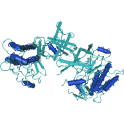
- Remove this product from my favorite's list.
- Add this product to my list of favorites.
Products
Viewed products
Newsletter
 |  |  |  |  |  |

TIE2 (Tunica Interna endothelial cell kinase 2) is a transmembrane tyrosine kinase whose expression is highly enriched in the endothelium. The receptor tyrosine kinase regulates angiogenesis, endothelial cell survival, proliferation, migration, adhesion and cell spreading, reorganization of the actin cytoskeleton, but also maintenance of vascular quiescence. Angiopoietins (Ang1-4) are ligands of TIE2 and modulate the kinase activity. Ang1 is an agonist of Tie2 whereas Ang2 seems to be a partial agonist/antagonist. The agonist Ang3 and antagonist Ang4 are poorly characterized. TIE2 signal initiation requires receptor tetramerization and is mediated by the presence of ligand dimers, tetramers, and higher-order multimers. TIE2 maintains anti-inflammatory effects by preventing the leakage of proinflammatory plasma proteins and leukocytes from blood vessels. Increased activity of TIE2 has been implicated in the promotion of pathological angiogenesis.
Recombinant Human TIE2 protein kinase domain, Angiopoietin-1 receptor, amino acids Q771-A1124, expressed in insect cells and affinity-purified as fusion protein (active).
Theoretical MW (TIE2) 66.9 kDa (fusion proteins)
Expression system: Baculovirus infected Sf9 cells
Purification: One-step affinity purification using glutathione agarose
Storage buffer: 50 mM Tris-HCl, pH 8.0; 100 mM NaCl, 5 mM DTT, 15 mM reduced glutathione, 20% glycerol
Protein concentration: 0.413 mg/ml (Bradford method using BSA as standard protein)
Method for determination of Km value & specific activity: Filter binding assay MAFC membrane
Specific activity : 112.000 pmol/mg
Ordering information: shipped on dry ice
Entrez Gene ID: 7010
UniProtKB: Q02763
Davis S, Aldrich TH, Yancopoulos GD et al. (1996) "Isolation of angiopoietin-1, a ligand for the TIE2 receptor, by secretion-trap expression cloning" Cell 87(7):1161-9
Tomer Shlamkovich, Lidan Aharon, Dana Koslawsky, Yulia Einav, Niv Papocorresponding (2018) “Targeting the Tie2–αvβ3 integrin axis with bi-specific reagents for the inhibition of angiogenesis” BMC Biol. 16: 92.
William A. Barton, Annamarie C. Dalton, Tom C.M. Seegar, Juha P. Himanen, Dimitar B. Nikolov(2014) “Tie2 and Eph Receptor Tyrosine Kinase Activation and Signaling.”Cold Spring Harb Perspect Biol; 6(3)
Lauri Eklund, Jaakko Kangas, Pipsa Saharinen (2017) „Angiopoietin–Tie signalling in the cardiovascular and lymphatic systems” Clin Sci (Lond) 1; 131(1): 87–103.
Samir M. Parikh (2017) “The Angiopoietins and Tie2 in Vascular Inflammation” Curr Opin Hematol. 24(5): 432–438.
Niu XL, Peters KG, Kontos CD (2002) "Deletion of the carboxyl terminus of Tie2 enhances kinase activity, signaling, and function. Evidence for an autoinhibitory mechanism" J Biol Chem. 277(35):31768-73
Hughes DP, Marron MB, Brindle NP (2003) "The antiinflammatory endothelial tyrosine kinase Tie2 interacts with a novel nuclear factor-kappaB inhibitor ABIN-2" Circ Res. 92(6):630-6
Arai F, Hirao A, Suda T et al. (2004) "Tie2/angiopoietin-1 signaling regulates hematopoietic stem cell quiescence in the bone marrow niche" Cell 118(2):149-61
Follow us